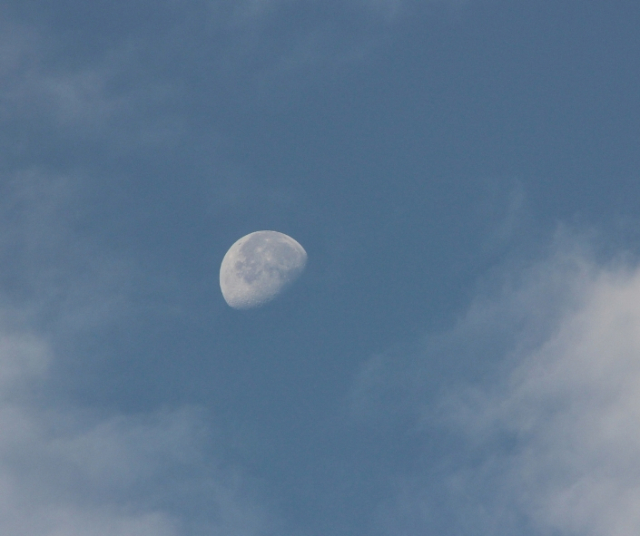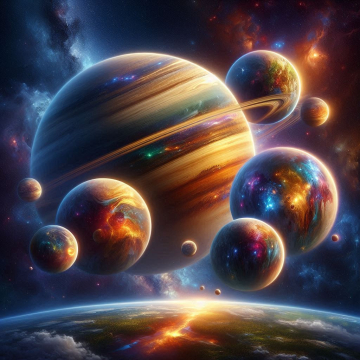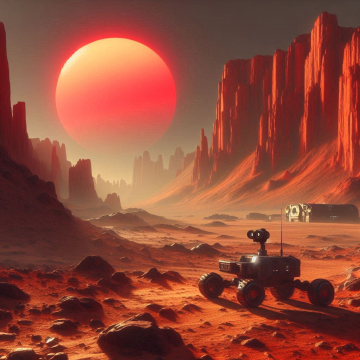The Moon , that natural satellite that has captured the imagination of humanity throughout history, is a constant presence in our skies. We often marvel at its beauty on starry nights, but what many people don't know is that it is also possible to observe the Moon during the day.
The Moon has been an object of fascination since time immemorial. It has been observed and studied for centuries, and has played a crucial role in navigation, agriculture, and human culture in general. But why can we see the Moon during the day? To understand this, we must first keep in mind some key concepts.
The Moon is the natural satellite of the Earth and is located at an average distance of approximately 384,400 kilometers from our planet. Its size is significantly smaller than Earth, with a diameter of around 3,474 kilometers, which is equivalent to about a quarter of the Earth's diameter. Due to its proximity to the Earth and its reflection of sunlight, the Moon is visible both day and night, but observing it during the day can be more difficult due to the presence of the bright sun.
The Lunar Orbit and the Illumination of the Moon
One of the key factors that allows us to see the Moon during the day is its orbit around the Earth. The Moon follows an elliptical orbit around our planet, which means that its distance varies along its path. When the Moon is on the side of the Earth opposite the Sun, we experience the full Moon. At this time, the Moon is visible for much of the night, and it is easy to observe at night.
However, the Moon is not always in the opposite position to the Sun. As it progresses in its orbit, it is in different phases, such as the waxing Moon, the waning Moon, and the new Moon. When the Moon is in a waxing phase, it is often visible during the day due to its position in the sky.
The position of the Moon in the sky during the day is also related to its phase and its position relative to the sun. During the new Moon, the Moon is aligned with the Sun in the sky and is not visible during the day as it is on the same side of the sky as the Sun. However, as it moves into the crescent phase, Its angular position with respect to the Sun changes. This means that the Moon rises in the east during the morning and is present in the sky for much of the day.
Sunlight and Reflection on the Moon
To understand why we can see the Moon during the day, it is important to take into account how the reflection of sunlight on the lunar surface works. The Moon does not emit its own light; Instead, it shines because it reflects light from the Sun. The Moon's surface is covered in dust, rocks, and craters, and these elements reflect sunlight back to Earth.
When the Sun is high in the sky during the day, sunlight hits the lunar surface directly, illuminating it brightly. This reflected light travels through space and reaches Earth, allowing us to see the Moon during the day. The reflection of sunlight off the lunar surface is what makes the Moon visible even in daylight.
Atmospheric Dispersion and the Moon by Day
Atmospheric dispersion is another factor that influences our ability to see the Moon during the day. When we look at the sky during the day, we see that the Sun's light is scattered in all directions due to the Earth's atmosphere. This scattering of light creates the blue sky we see during the day.
Sunlight reflected from the Moon also undergoes atmospheric dispersion on its way to Earth. This scattering causes the Moon's light to scatter in different directions, often making it less bright than it would be if we observed it in outer space. However, atmospheric dispersion does not prevent us from seeing the Moon during the day, although its brightness may vary depending on atmospheric conditions.
The Role of the Moon's Position in the Sky
The Moon's position in the sky during the day depends on its phase and its position in its orbit. During the first quarter phase, the Moon rises in the east in the morning and moves west during the day. This means that it can be visible during much of the daytime, depending on the time we observe it.
In contrast, during the last quarter phase, the Moon rises in the east during the afternoon and moves west during the night. In this phase, the Moon is more visible at night and less visible during the day. The phase of the Moon, along with its position in the sky, determines how long we can see it during the day.
The Importance of Daytime Moon Observation
The ability to observe the Moon during the day is not only an interesting phenomenon, but has also been important throughout history and in various cultures. Observing the Moon during the day has been essential for maritime navigation, agriculture, and planning religious events and festivals in many societies.
In maritime navigation, the Moon has been used as a reference to determine the position of a vessel at sea. Sailors observed the position of the Moon during the day and night to determine its latitude and therefore its location in the ocean. This was essential to avoid shipwrecks and ensure safe travel.
In agriculture, observing the Moon during the day has been used to determine optimal times for planting and harvesting crops. Some cultures believed that the phases of the Moon affected the growth of plants, and therefore scheduled their agricultural activities around the Moon.
In many religious and cultural traditions, the Moon also plays an important role. Observation of the Moon by day and night was used to determine the dates of festivals and religious celebrations. The full moon, in particular, has been a symbol of renewal and change in many cultures.
Conditions for Observing the Moon by Day
Although observing the Moon during the day is possible, it is not always easy due to various conditions that can influence its visibility. Here are some important considerations:
- Moon Phase: The phase of the Moon is a crucial factor. During the full Moon, it is easy to see at night, but can be difficult to see during the day. On the other hand, during the crescent phase, it is more likely to be visible during the day.
- Time of Day: The time of day is also important. During midday, when the Sun is at its highest point in the sky, the Moon can be difficult to see due to the intensity of the sunlight. On the other hand, it is easier to see it in the morning or afternoon, when the Sun is lower in the sky.
- Atmospheric Conditions: Sky clarity and atmospheric conditions can influence the visibility of the Moon during the day. Cloudy days or days with a lot of air pollution can make observation difficult.
- Geographic Location: Geographic location also plays a role. In some regions of the world, it is easier to see the Moon during the day due to the position of the lunar orbit and the time of day.
- Optical Instruments: Using binoculars or telescopes can make observing the Moon during the day more interesting and detailed, allowing you to appreciate features such as craters and lunar seas.
Curiosities about the Moon by Day
Observing the Moon during the day has led to some curiosities and myths throughout history. Here are some interesting facts:
Legends and Myths: In many cultures, the Moon by day has been associated with myths and legends. Some ancient civilizations believed that the Moon by day was a harbinger of important events or divine signs.
Changes in Color: Sometimes the Moon during the day can appear slightly discolored or even reddish. This is due to atmospheric scattering, which filters out blue and green light and allows red light to reach Earth.
Effect of Atmosphere: When the Moon is close to the horizon, it may appear larger than it really is. This is due to an optical effect caused by the Earth's atmosphere, known as the lunar illusion.
Moon by Day Photography: The Moon by day is a popular subject for astronomical photography. With modern technology, astronomers and amateurs can capture stunning images of the Moon during the day.
The ability to observe the Moon during the day is a fascinating reminder of how our solar system and atmosphere interact to create amazing celestial phenomena. The Moon, our natural satellite, continues to be a source of wonder and mystery, and its daytime visibility is just one of the many aspects that make it so intriguing. The next time you look up at the sky on a sunny day, take a moment to look for the Moon. It may be there, waiting to be observed in its daytime majesty.






